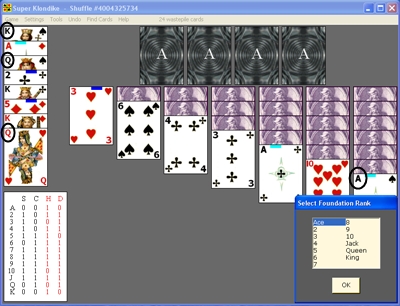Ten new games included in the Solitaire Games of Skill collection are described below.
Each game listing has two game names separated by a hyphen. The first name is the name of the game related
to the new game. The second name is the name of the new game.
-
Solitaire (Klondike) - Klondike Cache
The game Solitaire is a one deck game that also goes by the name Klondike. The original rules for Klondike require that the cards be dealt one at a time, sequences cannot be broken but have to be moved as a whole, and there are no redeals. These rules make the Klondike difficult to win. Klondike Cache is a two deck game that adheres to these rules while allowing the player to move cards from the hand or wastepile to three cells. Thus some cards valuable to the player will not get buried in the wastepile. Klondike Cache has a win rate of about 50% while preserving to a great extent the atmosphere of the original game. In the screenshot below the three cells are enclosed within a black rectangle. The black eight was placed on one of the cells because if a red nine shows up, the eight can be built on the nine. Then the circled red seven can be built on the eight, uncovering a facedown card. If a black jack shows up, the red ten on a cell can be built on the jack. Then one of the circled black nines can be built on the red ten, uncovering a facedown card.
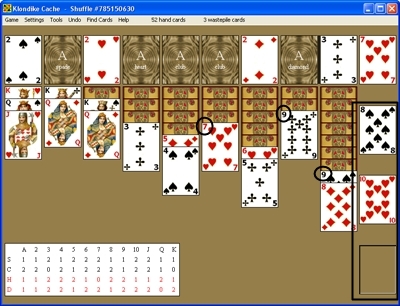
-
FreeCell - Free Kings
Free Kings is also a more challenging version of FreeCell. Free Kings has the same rules as FreeCell except that at the start of the game, three of the four cells are occupied by kings which makes these three cells useless at the start of the game. The game cannot really get going until the kings are free, hence the name Free Kings. In the screenshot below the four cells are in the upper left corner while the four foundations are in the upper right corner. The 8 column tableau is below the cells and foundations. The following gives a sample sequence of moves for freeing a king near the start of the game. The circled black two in column 6 of the tableau can be built on the red three on column 4 of the tableau. This would allow the two of diamonds and two of hearts in column 6 to be built on the foundation aces. Then the circled red six of column 6 can be built on the black seven in column 3. The circled black five in column 2 can be built on the red six now in column 3. This uncovers the black queen in column 2. The bottom red jack in column 6 can be built on the black queen of column 2 creating a space. A red king and a black queen from the cells can then be moved into the space.
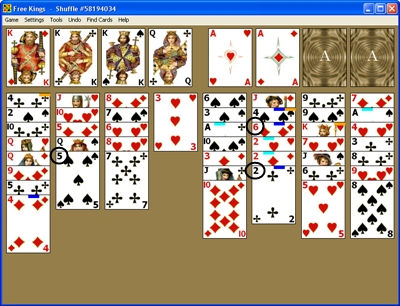
-
Spider - Autumn Leaves
Autumn Leaves invented by Toby Ord is a one deck version of Spider where only top cards of the same suit can be built down on each other. To offset this restriction, the difference in ranks when building downward does not have to be one. For example, in the screenshot below the circled ace of clubs in column 4 can be built on the jack of clubs in column 1. Suit sequences can be moved as a whole. A space can be filled by any card. Thus after moving the ace of clubs to column 1, the seven of clubs and the cards above it can be moved to the space in column 6. Then the ace of clubs now in column 1 can be moved back onto the seven of clubs sequence in column 6. This will enable the ten of clubs in column 4 to be moved onto the jack of clubs in column 1. Then the four of hearts in column 3 can be built on the five of hearts in column 4 which can then be built on the eight of hearts in column 3, creating a space. The back and forth card movement resembles the back and forth movement of autumn leaves, hence the name. Cards cannot be removed from the game as in Spider. The object of the game is to move all the cards to four columns each column a complete suit of cards in sequence from ace to king. When play comes to a standstill one card is dealt to each column as in Spider. But spaces do not have to be filled before cards are dealt. There are five deals.
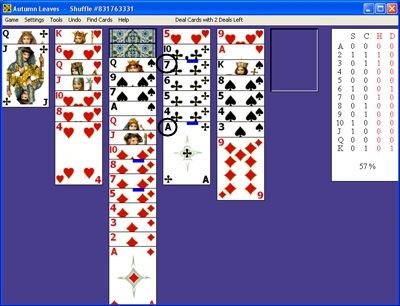
-
La Belle Lucie - La Belle Cell
La Belle Lucie frequently presents the player with an unwinnable situation at the end of three deals even if you are allowed to draw a card out from below the top of a column and place it on the tableau or a foundation. After three deals of work this result can be frustrating. La Belle Cell has the same rules as La Belle Lucie except there is only one deal instead of three and cards at the top of a column can be moved to a cell. While unwinnable patterns still show up, you do not have to fight through three deals in order to find the case hopeless. And many situations which would result in the loss of the game in La Belle Lucie can be fought through in La Belle Cell. For example the ten and nine of spades which are circled in the screenshot below cover the six of spades. According to La Belle Lucie rules this game would be lost. However here the nine can be moved to the cell allowing the ten to built on the circled jack of spades. The nine can be in turn built back on the ten, freeing up the cell for further use. The circled queen of clubs can be moved to the cell freeing the two of clubs. The queen of clubs can then be built on the circled king of clubs. Also the circled seven of diamonds can be moved to the cell freeing the nine of clubs. Then the seven can be built on the circled eight of diamonds.
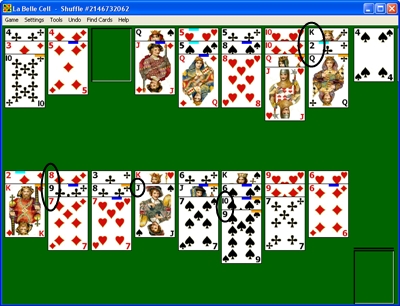
-
Buffalo Bill - Pyramid Bill
Pyramid Bill is a one deck version of Buffalo Bill with a pyramid thrown in. The object of the game is to move all the cards to the foundations. Like Bisley Pyramid Bill has eight foundations as shown in the upper left corner of the screenshot below. Below the foundations are seen seven cells and below the seven cells the reserve runs along the bottom margin. Cards from the reserve and Pyramid whose bottom margins are uncovered can be moved to the cells or to the foundations. Otherwise there is no other building. The first priority is to unpack the cards in the pyramid. The cards lower in the pyramid have a lot of low rank spades and a five of hearts. If the cards indicated by the black rectangles are moved to the cells, the ace and deuce of spades would be uncovered as well as the ace of hearts. Then all the lower rank spades in the cells together with the five of hearts and some cards in the reserve could be moved to the foundations.
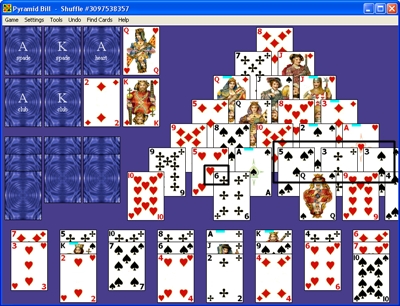
-
Nestor - King Nestor
King Nestor is a version of the game Nestor. Available cards of the same rank can be paired and removed. The object of the game is to remove all the cards from the tableau. As seen in the acompanying screen shot, King Nestor does not have any reserve cards. To offset this advantage King Nestor allows the player to move any card below the top of its column to the top of its column. This can happen three times. In the screen shot below, the only two cards of rank five left are circled. The five in column five covers a circled nine while the five in column five is covered by a circled nine. If this was the standard Nestor game, the game would be lost since the fives cannot be paired because of the nines and vice versa. Notice that the fives are flagged with orange and the nines are marked with dark blue. The nine in column five would be a good card to bring to the top since this would release the fives to be paired.
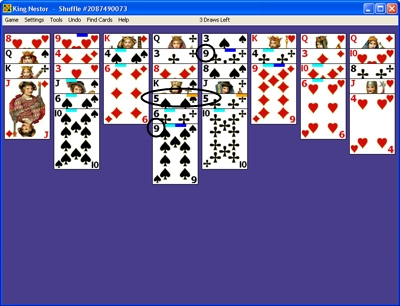
-
Russian Solitaire - Russian Scorpion
Russian Solitaire is one of the most difficult games to win. Part of the problems is that there are many scenarios under which the game is unwinnable. One such scenario is if three consecutive cards in a column all having the same suit have consecutive ranks with the middle card having the smallest rank and the lowest card having the largest rank. For example a card sequence in a column of five, three, and four of hearts would make the game unwinnable since the cards could not be separated by building on the tableau or foundation. Also if the faceup card covering a column of facedown cards covers a card of the same suit and one rank higher and also a card of the same suit and a lower rank, the game is unwinnable since the faceup card cannot be built anywhere. These and other unwinnable games are thrown out when playing Russian Scorpion which follows the rules of Russian Solitaire except that there are fewer facedown cards as seen in the accompanying screenshot and there is a deal of four cards as in the game Scorpion. The circled seven of diamonds in the screenshot is marked with orange indicating that it can be used to pick up the circled six of diamonds.
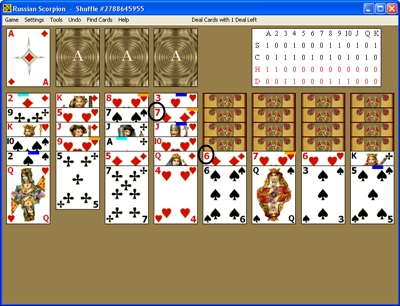
-
Senate - Little Senate
Little Senate is a one deck version of the two deck game called Senate. Little Senate differs from the two deck game in that cards are not dealt to wastepiles. All the cards start the game visible in a sixteen column reserve as seen in the middle of the screen shot below. The object of the game is to move all aces to the foundatons and build them up by suit to kings. The foundations are in the upper left corner of the screen shot while the four column tableau is along the right margin. Cards of the same suit may be built downward on the tableau. Cards in sequence can be moved as a whole. When playing Little Senate only games that allow you to make a space in the tableau are offered if the game filter is turned on. The rest of the games are thrown out. To make a space in the game seen below, the circled queen of spades in the reserve can be moved to the king of spades in the tableau. The circled queen of diamonds can be built on the king of diamonds in the tableau. The circled jack of diamonds can be built on the queen in the tableau which will allow the circled ace of spades to move to the foundations. This will allow the circled two of spades of the reserve and the circled three of spades in the tableau to move to the foundations.
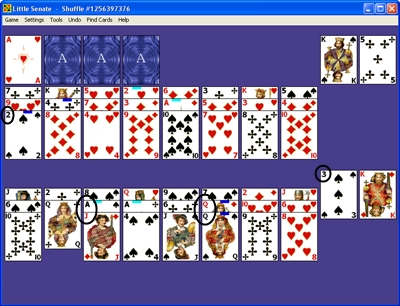
-
Miss Milligan - Free Space
When playing Miss Milligan most of the moves are fairly obvious with little skill involved until all the cards are dealt and the reserve space becomes available. When playing Free Space skillful play is required from the start. The object of the one deck Free Space game is to move all aces to the foundatons and build them up by suit to kings. In the screenshot below the foundations are the 4 columns in the upper left corner. Two of the aces start the game on the foundations. Below the foundations are the 6 tableau columns where all the cards except the 2 aces start the game. There are no deals. Top cards on the tableau can be built down on each other by alternating color or built on the foundations. Alternating color sequences can be moved as a unit. Spaces are filled by kings or sequences headed by kings. Tableau sequences can be moved to three reserve spaces which are shown in the upper right corner of the screenshot. As an example of Free Space play, in the screenshot below the sequence headed by the circled queen of clubs in the tableau can be moved to a space in the reserve. The sequence headed by the circled four of clubs can then be built on the five of hearts in column 6. The sequence headed by the circled queen of diamonds can be built on the king of clubs in column 4. This allows the queen of clubs sequence in the reserve to be built on the king of diamonds in column 3.
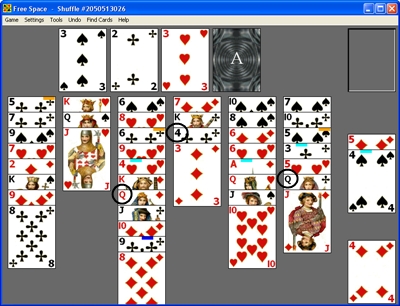
-
Klondike - Super Klondike
Super Klondike is a version of the Microsoft Solitaire game which deals the cards by threes with unlimited redeals. Having to go through the deck many times can be tedious. The wastepile displayed for this game tries to duplicate the dealing process while reducing the amount of card manipulation. An example of the wastepile is the column of cards along the left margin of the accompanying screenshot. The wastepile cards seen by the player are the wastepile cards he would see when counting off the cards by threes. In the regulation game, if a player plays a wastepile card he would not be able to retrieve covered wastepile cards until the next redeal. This rule is duplicated here by not allowing access to cards above a played card that would not be acessible in a regulation game. A black bar divides the accessible cards from the inaccessible. The dialog box in the lower middle of the screen allows the player to choose the rank of the starting foundation cards based on the cards visible. In this case queens might be the best base foundation cards, since there are two queens, which are circled, available in the wastepile. Also when the queen of spades is sent to the foundations, the circled king of spades at the top of the wastepile and the circled ace of spades on the tableau can also be moved to the foundations.
